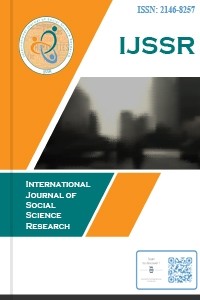Bulanık Ortalama Mutlak Sapma Modeli İle Portföy Optimizasyonu: BİST 30 Örneği
Portföy Optimizasyonu, Ortalama Mutlak Sapma, Bulanık Mantık
Portfolio Optimization with Fuzzy Mean Absolute Deviation Model: Evidance from BİST 30
___
- Aliev, R., Abiyev, R. and Menekay, M. (2008). Fuzzy Approach to Portfolio Selection Using Genetic Algorithms. Intelligent Automation and Soft Computing, 14(4):525-540.
- Baykal, N. ve Beyan, T. (2004). Bulanık Mantık İlke ve Temelleri. Ankara: Bıçaklar Kitabevi.
- Bekçi, İ. (2001). Optimal Portföy Oluşturulmasında Bulanık Doğrusal Programlama Modeli ve İMKB’de Bir Uygulama. Yayımlanmamış Doktora Tezi. Süleyman Demirel Üniversitesi Sosyal Bilimler Enstitüsü, Isparta.
- Cebeci, M. (2011). Bulanık Doğrusal Programlama ile Portföy Optimizasyonu. Yayımlanmamış Yüksek Lisans Tezi, Selçuk Üniversitesi Fen Bilimleri Enstitüsü, Konya.
- Çevik, O. ve Yıldırım, Y. (2010). Bulanık Doğrusal Programlama ile Süt Ürünleri İşletmesinde Bir Uygulama. Karamanoğlu Mehmetbey Üniversitesi Sosyal ve Ekonomik Araştırmalar Dergisi, 12(18):15-26.
- Erdaş, M.L. ve Demir, Y. (2016). Bulanık Doğrusal Programlama Yöntemiyle Bir Portföy Optimizasyonu Modelinin Geliştirilmesi: BİST30 Endeksinde Bir Uygulama. Uluslararası Sosyal Araştırmalar Dergisi, 9(45):768-789.
- Fabozzi, F.J., Kolm, P.N., Pachamanova, D.A. and Focardi, S.M. (2007). Robust Portfolio Optimization and Management (1. Edition). New Jersey: John Wiley & Sons.
- Gülcan, B. (2012). Bulanık Doğrusal Programlama ve Bir Bisküvi İşletmesinde Optimum Ürün Formülü Oluşturma. Yayımlanmamış Yüksek Lisans Tezi, Karamanoğlu Mehmetbey Üniversitesi Sosyal Bilimler Enstitüsü, Karaman.
- Güngör, İ., Aycan, M. ve Demir, Y. (2005). Bulanık Ortamda Portföy Optimizasyonu. Sosyal Ekonomik Araştırmalar Dergisi, 10:104-120.
- Hansen, K. B. (1996). Fuzzy Logic and Linear Programming Find Optimal Solutions for Meteorological Problems. Novo Scotia: Terms Paper for Fuzzy Course at Technical University of Nova Scotia.
- İskenderoğlu, Ö. ve Karadeniz, E. (2011). Optimum Portföyün Seçimi: İMKB 30 Üzerinde Bir Uygulama. Cumhuriyet Üniversitesi İktisadi ve İdari Bilimler Dergisi, 12(2):235-257.
- Kocadağlı, O. (2006). Bulanık Matematiksel Programlama ve Portföy Analizi Uygulaması. Yayımlanmamış Yüksek Lisans Tezi, Mimar Sinan Güzel Sanatlar Üniversitesi Fen Bilimleri Enstitüsü, İstanbul.
- Konak, F. ve Bağcı, B. (2016). Fuzzy Linear Programming on Portfolio Optimization: Empirical Evidence from FTSE 100 Index. Global Journal of Management and Business Research: C Finance, 16(2):65-69.
- Konno, H. and Yamazaki, H. (1991). Mean-Absolute Deviation Portfolio Optimization Model and Its Applications to Tokyo Stock Market. Management Science, 37(5):519-531.
- Markowitz, H. (1952). Portfolio Selection. The Journal of Finance, 7(1):77-91.
- Pai, G.A.V. and Michel, T. (2010). Fuzzy Decision Theory Based Optimization Of Constrained Portfolios Using Metaheuristics. University Grants Commission. Major Research Project 2010, F.No. 39-125/2010(SR).
- Pelitli, D. (2007). Portföy Analizinde Bulanık Mantık Yaklaşımı ve Uygulama Örneği. Yayınlanmamış Yüksek Lisans Tezi, Pamukkale Üniversitesi Sosyal Bilimler Enstitüsü, Denizli.
- Sarokolaei, M.A., Salteh, H.M. and Edalat, A. (2013). Presenting a Fuzzy Model for Fuzzy Portfolio Optimization with the Mean Absolute Deviation Risk Function. European Online Journal of Natural and Social Sciences. Vol.2, No. 3, pp. 1793-1799.
- Solatikia, F., Kiliç, E. and Weber, G.W. (2014). Fuzzy Optimization for Portfolio Selection Based on Embedding Theorem in Fuzzy Normed Linear Spaces. Organizacija Journal of Management, Informatics and Human Resources, 47(2):90-97.
- Şen, Z. (1999). Mühendislikte Bulanık (Fuzzy) Modelleme İlkeleri. İstanbul: İ.T.Ü. Uçak Ve Uzay Bilimleri Fakültesi.
- Tuncel, S. Ö. (1997). Bulanık Doğrusal Programlama. Yayımlanmamış Yüksek Lisans Tezi, Hacettepe Üniversitesi Fen Bilimleri Enstitüsü, Ankara.
- Verdegay, J.L. (1982) Fuzzy Mathematical Programming, in: M.M. Gupta, E. Sanchez (Eds.), Fuzzy Information and Decision Processes, Amsterdam:North-Holland. Wang, L.X. (1997). A Course in Fuzzy-Systems and Control (1. Edition). Eastbourne: Prentice Hall Inc,.
- Wang, S. and Xia, Y. (2002). Portfolio Selection and Asset Pricing (1.Edition). Berlin: Springer-Verlag.
- Werners, B. (1987). An Interactive Fuzzy Programming System. Fuzzy Sets and Systems, 23:131-147.
- Zadeh, L. A. (1965). Fuzzy Sets. Information and Control, 8(3):338-353.
- Zimmermann, H.J. (1983). Fuzzy Mathematical Programming. Computers & Operations Research, 10(4):291-298.
- Zimmermann, H.J. (1991). Fuzzy Set Theory and Its Applications. Massachusetts: Kluwer Academic Publishers.
- Yayın Aralığı: Yılda 2 Sayı
- Başlangıç: 2012
- Yayıncı: Şahin ORUÇ
Nuray YILDIRIM, Nuray KURTDEDE FİDAN, Selcen Süheyla ERGÜN
Planlı Dönemden Önce Kentleşme Politikalarındaki Sorunların Günümüze Yansımaları
Sosyal Bilgilerin Otantik Öğretiminde Yeni Yaklaşımlar
Zekeriya Fatih İNEÇ, Erdal AKPINAR
İstanbul Şehrinde Ağırlıklı Nüfus Merkezinin Değişimi ve Nedenleri: 1990-2010 Dönemi
Ülkeler Bazında Katılım Bankacılığının Performanslarının Karşılaştırılması
Ersin Afacan, Zeynep ONAĞ, Doğan Demiran, Gökhan Çobanoğlu
Bulanık Ortalama Mutlak Sapma Modeli İle Portföy Optimizasyonu: BİST 30 Örneği
Ömer İSKENDEROĞLU, Saffet AKDAĞ
İstanbul’da Banliyöleşme ve Banliyöleşme Sonrası Kentleşme
Öğretmenlerin “Okul” Kavramına İlişkin Metaforlarının İncelenmesi
